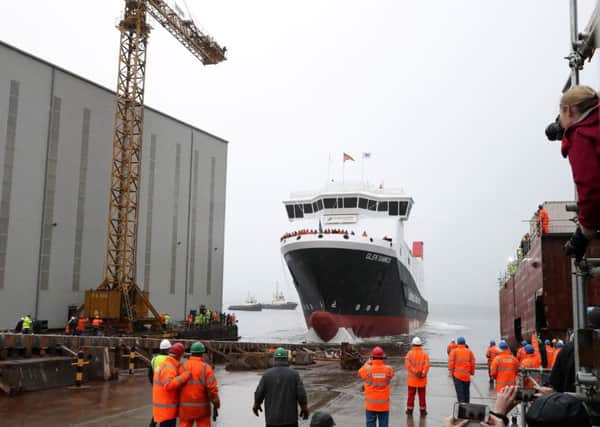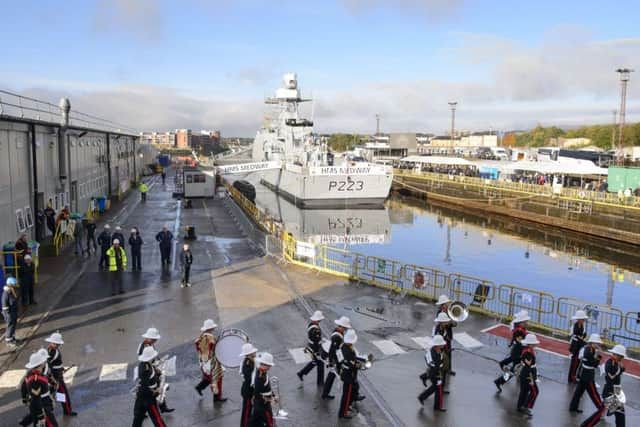Will 2018 be plain sailing for the Clyde shipyards?


The vessel was the first dual-fuel passenger ferry built in the UK and represented a turning point for its builders, Ferguson Marine Engineering Limited (FMEL). The Port Glasgow-based company was days from going bust in 2014 before being rescued by Clyde Blowers Capital. As the last commercial yard on the river, its closure would have represented a grievous blow to the country’s already diminished industrial capacity.
Its renaissance can be illustrated by more than just ship launches. There are now more than 360 staff on the books - up from just 47 when the yard was bought. That figure is likely to rise as and when more orders are secured.
Advertisement
Hide AdAdvertisement
Hide AdJim McColl, the billionaire industrialist and founder of Clyde Blowers, has previously talked of a five-year transformation of FMEL with up to 1,300 jobs being created. Key to this expansion is diversifying the type of contracts the yard can bid for - a push towards renewables as well as shipbuilding.


Entering the defence market is also on the cards. This month, FMEL was revealed as part of a consortium bidding to win the Type 31e frigate contract from the Ministry of Defence (MoD).
The future of shipbuilding on the west coast is of course about much more than business. Both the UK and Scottish Governments are acutely aware of “the politics of the Clyde”, as one source put it to the BBC in 2013 following the decision to end naval shipbuilding in Portsmouth.
That was good news for workers at the Govan and Scotstoun yards owned by defence giant BAE, which took the decision to consolidate its warship capability in Glasgow.


2018 will be a busy year for the biggest remaining shipbuilder on the Clyde. Work continues on the River Class offshore patrol vessels (OPVs) contract it secured in 2013, with two of five vessels already afloat. The latest, HMS Medway, was named at Scotstoun in October.
BAE currently employs 2,600 staff through its naval ships division in Glasgow, and will recruit more apprentices in the coming months.
But the company’s future on the Clyde currently rests on the successful completion of Type 26 frigate contract, described as “the UK’s core shipbuilding programme for the next 18 years”.
Eight vessels are planned - but only contracts for the first three have been signed off, in a deal worth £3.7 billion. Early work on HMS Glasgow, the first of the Type 26s, is currently progressing at Govan. Securing a future deal for the remaining five vessels is a key priority for BAE.
Advertisement
Hide AdAdvertisement
Hide AdDefence bosses and UK Government ministers claim the OPV and Type 26 contracts combined secure the future of the Clyde yards until the 2030s.
But some Glasgow MPs are not so certain. They point to BAE’s decision not to proceed with a “frigate factory” at Scotstoun, which was first talked about in 2013, as proof the company is hedging its bets on future orders. The company in turn points to the on-going investment it has made at both Clyde yards and its determination to deliver the Type 26 fleet.
There is also concern that three naval support ships will be built overseas after no UK yards bid for the work.
In a Commons debate on the UK’s shipbuilding strategy, SNP MP Chris Stephens said auxiliary ships should not be built abroad.
He added: “This country has just completed a process during which the Aircraft Carrier Alliance was built across shipyards in the UK. If that was good enough for the Alliance, surely it is good enough for Royal Fleet Auxiliary ships. I do not believe that sending Royal Fleet Auxiliary ships to international competition will save the Ministry of Defence money — far from it.”
Labour’s Paul Sweeney called for the UK Government to fund a frigate factory at Scotstoun as it would offer an integrated site which would provide value for money for the Royal Navy.
Yet the message from both BAE and Ferguson is that the Clyde yards are looking ahead to 2018 with confidence.
While the days when shipbuilding on the river directly employed 55,000 men - a high point reached at the end of the Second World War - are long gone, the industry believes it is ready for any stormy waters that may lie ahead.
